The Best Birch Trees for Your Garden: Species Comparison and Planting Tips
Published: August 22, 2025 at 9:06:32 AM UTC
Birch trees bring unmatched elegance to any garden with their distinctive bark, graceful form, and seasonal interest. These iconic trees create a striking focal point in landscapes large and small, offering year-round beauty with relatively little maintenance. Whether you're drawn to their ghostly white trunks, peeling bark textures, or golden autumn foliage, there's a birch variety perfectly suited to your garden's conditions. In this comprehensive guide, we'll explore the most garden-worthy birch species, compare their unique characteristics, and provide expert planting advice to help your trees thrive for decades to come. From compact varieties for small spaces to disease-resistant selections for challenging sites, you'll discover the perfect birch to enhance your outdoor sanctuary.
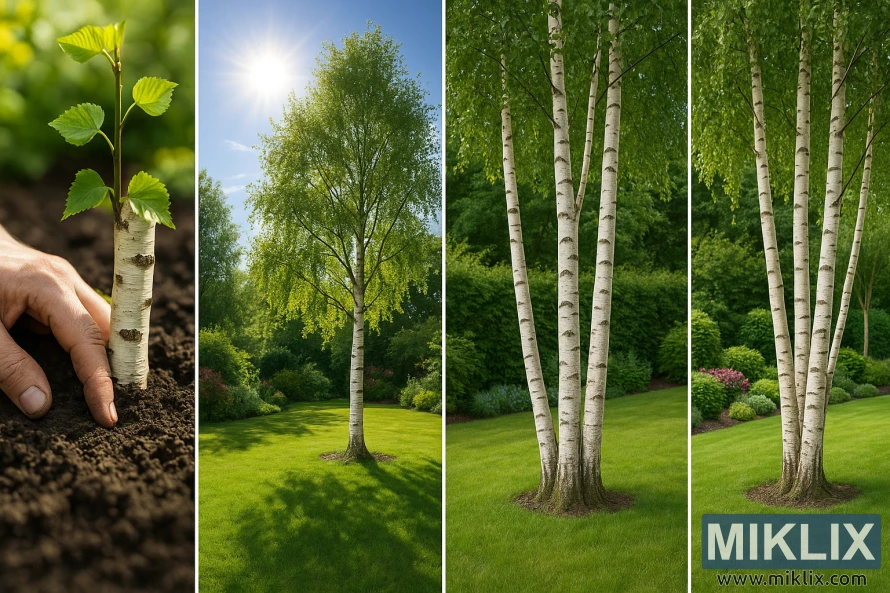
Key Considerations Before Planting Birch Trees
Before selecting the best birch trees for your garden, it's important to understand their growing requirements. While birches are generally adaptable, they'll perform best when their basic needs are met:
Soil Preferences
Most birch trees prefer moist, well-drained soil with slightly acidic to neutral pH. River birch can tolerate wetter conditions, while silver birch adapts to drier sites once established. Avoid heavy clay soils unless amended with organic matter to improve drainage.
Sunlight Requirements
Birches thrive in full sun to partial shade. In hotter regions (USDA zones 6-9), they benefit from afternoon shade to protect their shallow roots from heat stress. Northern exposures often provide ideal conditions in warmer climates.
Space Considerations
Most birch species reach 40-60 feet tall with a spread of 20-35 feet at maturity. Plan accordingly when positioning your tree, keeping in mind overhead utility lines and proximity to structures. For smaller gardens, consider dwarf varieties or multi-stem specimens that create vertical interest without excessive spread.
Climate Adaptability
Different birch species have varying hardiness ranges. Paper birch thrives in cooler northern regions (USDA zones 2-6), while river birch tolerates the heat and humidity of southern gardens (zones 4-9). Always select species appropriate for your local climate for best results.
Top 5 Birch Species for Gardens
After consulting with horticulturists and evaluating performance across different garden settings, we've identified these five birch varieties as the best choices for home landscapes. Each offers unique ornamental features and adaptability to various growing conditions.
Paper Birch (Betula papyrifera)
Paper birch is beloved for its brilliant white, peeling bark that creates stunning winter interest. Native to North America, this iconic tree forms a graceful, pyramidal shape that matures to 50-70 feet tall in optimal conditions.
- USDA Hardiness: Zones 2-6
- Mature Height: 50-70 feet
- Spread: 25-35 feet
- Distinctive Features: Brightest white bark of any birch species; excellent drought tolerance once established; golden-yellow fall color
- Wildlife Value: Seeds attract finches and other songbirds; provides habitat for woodpeckers
Paper birch performs best in cooler northern climates. In warmer regions, consider river birch or Himalayan birch as alternatives.
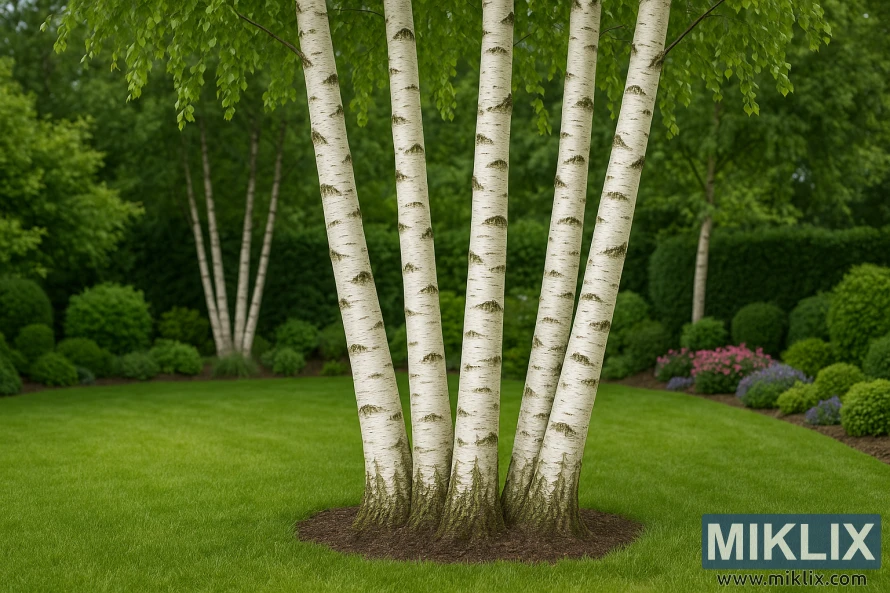
River Birch (Betula nigra)
River birch stands out with its cinnamon-colored, exfoliating bark that peels in thin, papery layers. This North American native is the most heat-tolerant birch species, making it ideal for southern gardens where other birches struggle.
- USDA Hardiness: Zones 4-9
- Mature Height: 40-70 feet
- Spread: 30-60 feet
- Distinctive Features: Exceptional tolerance for wet soils; attractive peeling bark in shades of cinnamon, salmon, and creamy white; excellent resistance to bronze birch borer
- Wildlife Value: Seeds and buds attract birds; provides nesting habitat
River birch is an excellent choice for rain gardens, pond edges, or areas with seasonal flooding. Its extensive root system helps stabilize soil in erosion-prone areas.
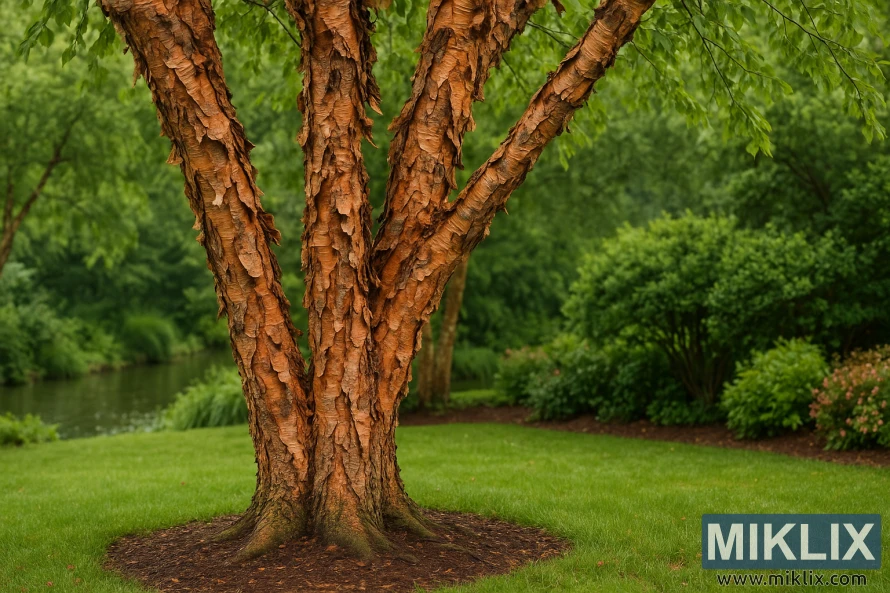
Dwarf Birch (Betula nana)
Dwarf birch is the perfect solution for small gardens where standard birch trees would overwhelm the space. This compact, shrub-like species grows slowly to form a dense, rounded shape with attractive rounded leaves and subtle bark texture.
- USDA Hardiness: Zones 2-7
- Mature Height: 2-3 feet
- Spread: 2-4 feet
- Distinctive Features: Extremely compact size; rounded, glossy leaves; attractive catkins in spring; golden-yellow fall color
- Wildlife Value: Provides cover for small birds and mammals
Dwarf birch works beautifully in rock gardens, alpine troughs, or as part of a mixed shrub border. It's also an excellent choice for bonsai enthusiasts.
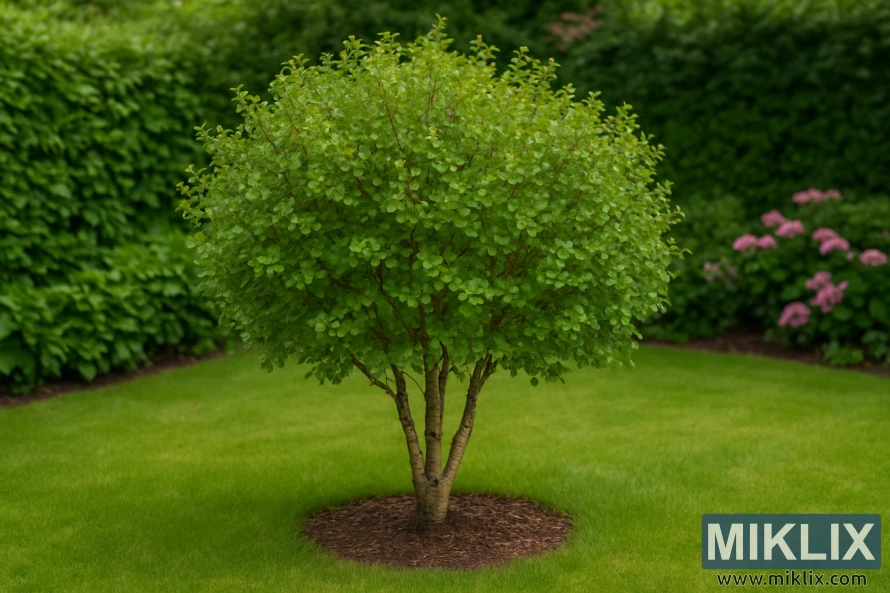
Silver Birch (Betula pendula)
Silver birch is the quintessential European birch, known for its elegant, slender form and silvery-white bark marked with black diamonds. Its slightly pendulous branches create a graceful silhouette, especially beautiful when planted in small groups.
- USDA Hardiness: Zones 2-7
- Mature Height: 40-50 feet
- Spread: 15-25 feet
- Distinctive Features: Elegant form with slightly weeping branches; silvery-white bark with distinctive black markings; diamond-shaped leaves with serrated edges; golden-yellow fall color
- Wildlife Value: Supports over 300 insect species; seeds attract finches and other birds
Silver birch creates a light, dappled shade that allows woodland plants like ferns, hostas, and spring bulbs to thrive beneath its canopy.
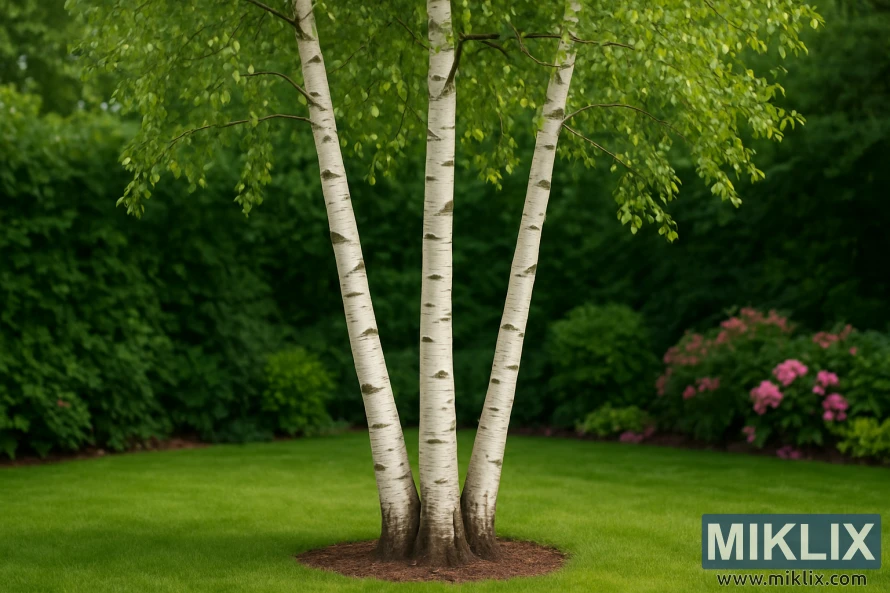
Heritage® River Birch (Betula nigra 'Heritage')
Heritage® is a superior cultivar of river birch developed for enhanced disease resistance and ornamental qualities. Its exfoliating bark reveals stunning layers of cream, salmon, and cinnamon colors, creating year-round visual interest.
- USDA Hardiness: Zones 4-9
- Mature Height: 40-50 feet
- Spread: 25-35 feet
- Distinctive Features: Superior disease resistance, especially to bronze birch borer; exceptional heat tolerance; more pronounced exfoliating bark than the species; glossy green leaves with silvery undersides
- Wildlife Value: Seeds attract birds; provides nesting habitat
Heritage® river birch is an excellent choice for gardeners in warmer regions where other birch species struggle. It combines the heat tolerance of river birch with enhanced ornamental qualities.
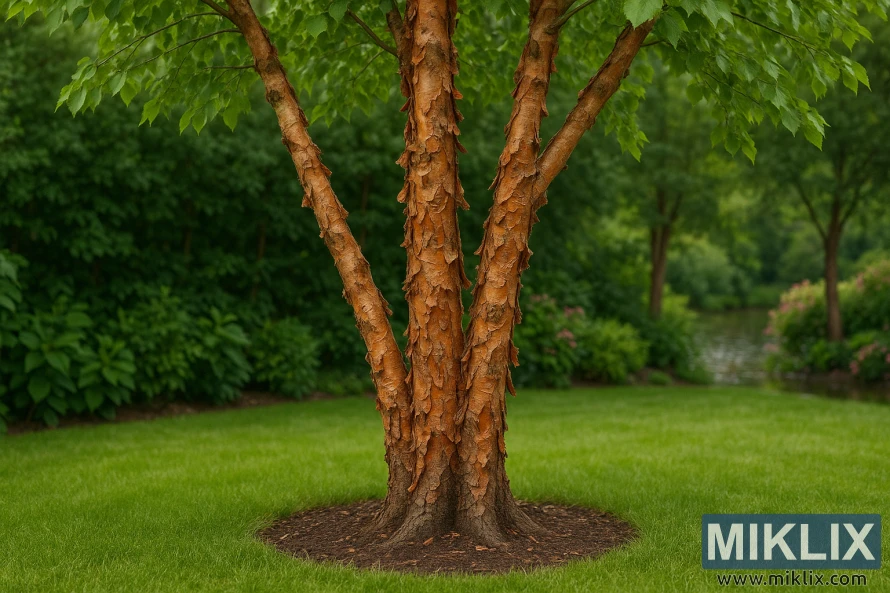
Birch Tree Planting & Care Guide
Follow these expert guidelines to give your birch tree the best possible start in your garden. Proper planting and early care establish the foundation for decades of healthy growth and ornamental beauty.
Step-by-Step Planting Instructions
- Timing: Plant birch trees in early spring or fall when temperatures are cool and rainfall is typically abundant. Avoid summer planting when heat stress can compromise establishment.
- Site Selection: Choose a location with morning sun and afternoon shade, especially in warmer regions. Ensure adequate space for the mature size of your chosen species.
- Soil Preparation: Dig a hole twice as wide as the root ball but no deeper than the height of the container or root ball. Roughen the sides of the hole to encourage outward root growth.
- Planting Depth: Position the tree so the root flare (where the trunk widens at the base) sits slightly above ground level. Planting too deeply is a common cause of birch tree failure.
- Backfilling: Use the native soil removed from the hole to backfill around the roots. Avoid amending the backfill with compost or fertilizer, which can discourage roots from expanding beyond the planting hole.
- Watering: Create a 3-inch high soil berm around the planting area and fill it with water. Allow it to drain completely, then repeat. This ensures deep hydration of the root zone.
- Mulching: Apply a 2-3 inch layer of mulch in a circle around the tree, keeping it at least 3-4 inches away from the trunk. Extend the mulch to the drip line if possible.
Seasonal Maintenance Calendar
| Season | Watering | Fertilizing | Pruning | Pest Monitoring |
| Spring | Weekly deep watering if rainfall is insufficient | Apply balanced slow-release fertilizer if soil test indicates deficiencies | Remove dead or damaged branches only | Check for aphids and leaf miners |
| Summer | Twice weekly during drought; water deeply to reach root zone | None | No pruning | Watch for bronze birch borer signs (D-shaped exit holes) |
| Fall | Weekly until ground freezes | None | Light structural pruning after leaf drop | Check for leaf spot diseases |
| Winter | Monthly on warm days if winter is dry | None | Major pruning in late winter before sap flow begins | Inspect bark for damage from rodents |
Common Birch Tree Mistakes to Avoid
Best Practices
- Plant birches where their roots stay cool and shaded
- Maintain consistent soil moisture, especially during establishment
- Mulch widely but keep mulch away from trunk
- Prune only during dormant season
- Plant in groups of three for natural woodland effect
Common Mistakes
- Planting too close to structures or other trees
- Allowing soil to dry out completely
- Creating "mulch volcanoes" against the trunk
- Pruning during spring when sap is flowing
- Damaging bark with string trimmers or mowers
Never "top" a birch tree by cutting off the upper portion of the trunk. This destructive practice ruins the tree's natural form, creates entry points for disease, and stimulates unsightly water sprouts. If your birch has outgrown its space, it's better to remove it entirely and replace it with a more appropriately sized species.
Protecting Birch Bark
The distinctive bark is a birch tree's most prized feature. Protect it by:
- Using trunk guards in winter to prevent rodent damage
- Maintaining a mulch ring to eliminate the need for mowing or trimming near the trunk
- Avoiding the temptation to peel loose bark, which can expose the tree to pests and diseases
- Gently cleaning white-barked species with diluted dish soap and water to remove algae (winter only)
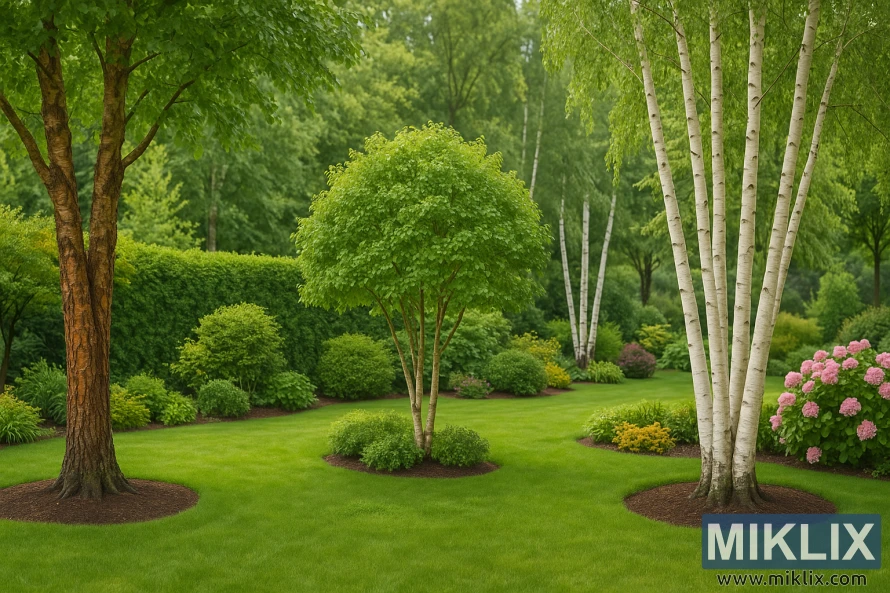
Frequently Asked Questions About Birch Trees
Do birch trees damage foundations or underground pipes?
Birch trees have relatively shallow, spreading root systems that rarely cause significant structural damage. However, they should still be planted at least 20 feet from foundations, septic systems, and underground utilities as a precaution. Their roots will seek out water sources, so they may infiltrate cracked pipes if planted too close. River birch is particularly aggressive in seeking water and should be given extra distance from structures.
Are birch trees messy in the garden?
Birch trees do create some seasonal litter, including small twigs, catkins in spring, and leaves in fall. However, they're considered moderately clean compared to many other deciduous trees. Their small leaves decompose quickly and make excellent mulch when left in place. The catkins and small branches that drop throughout the year are easily managed with regular garden maintenance.
How long do birch trees typically live?
Birch trees are generally considered short to medium-lived trees. In optimal conditions, most species live 40-50 years, though some specimens may reach 80-100 years. River birch tends to be longer-lived than paper or silver birch, especially in warmer climates. Regular care, proper siting, and protection from pests can help maximize your birch tree's lifespan.
Can I plant flowers or shrubs under my birch tree?
Yes, birch trees create light, dappled shade that allows many plants to thrive beneath them. Spring-flowering bulbs, ferns, hostas, astilbes, and woodland wildflowers make excellent companions. Avoid aggressive groundcovers that might compete for moisture, and never raise the soil level around established trees when creating underplantings. Maintain a mulch-only zone of at least 2-3 feet around the trunk.
Are multi-stem or single-stem birch trees better for gardens?
Both forms have their advantages. Multi-stem birches create more visual impact with their multiple trunks and work well as specimen trees in lawns or larger garden beds. Single-stem birches have a more formal appearance and can be limbed up to create space for underplanting. Multi-stem forms often show better stress tolerance since they have multiple pathways for water and nutrient transport.
Conclusion
Birch trees offer a perfect combination of elegant beauty and adaptability for today's gardens. Whether you're drawn to the iconic white bark of paper birch, the heat tolerance of river birch, or the compact form of dwarf varieties, there's a birch species perfectly suited to enhance your landscape.
For most home gardens, we particularly recommend Heritage® river birch for its disease resistance and adaptability across climate zones, silver birch for its classic elegance in cooler regions, and dwarf birch for small spaces where vertical interest is desired. Whichever species you choose, proper planting and care will reward you with decades of seasonal beauty.
Further Reading
If you enjoyed this post, you may also like these suggestions:
- A Guide to the Best Arborvitae Varieties to Plant in Your Garden
- The Best Linden Tree Varieties to Plant in Your Garden
- The Best Ginkgo Tree Varieties for Garden Planting
